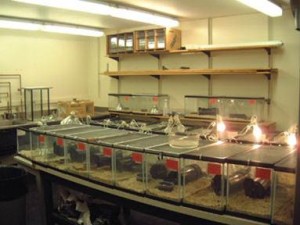Research in the “reptile lab” at Trinity College concentrates on functional morphology and evolution of reproductive specializations in lizards and snakes, notably features associated with viviparity (live-bearing reproduction) and oviparity (egg-laying reproduction).
Background: All animals reproduce in one of two ways: in oviparity, females lay fertilized or unfertilized eggs, whereas in viviparity, females give birth to their young. Although viviparity is characteristic of most mammals (including our own species), it also occurs in a wide variety of other animals. For example, about 20% of the species of lizards and snakes are viviparous, as are most sharks and various teleost fishes and amphibians. Viviparity also has been documented in various extinct forms, including plesiosaurs, ichthyosaurs, and placoderm fishes.
The fact that viviparity has originated in so many unrelated forms raises many functional and evolutionary questions. How do pregnant females sustain their developing embryos during pregnancy? How have the mechanisms of embryo sustenance evolved? For that matter, how and why has viviparity evolved from oviparity so often, and what factors have affected its evolution?
Our research. Research in my lab focuses primarily on viviparity in lizards and snakes. Such reptiles have evolved viviparity more frequently than all other vertebrates combined, making them an ideal group for study of this reproductive pattern. Our work has focused on three major areas:
1) Structure and function of reptile placentas — the organs through which pregnant females sustain their embryos;
2) Developmental morphology and evolution of fetal membranes — the tissues that sustain embryos in oviparous reptiles, providing oxygen, water and calcium. These tissues have been recruited in viviparous forms for placentation;
3) Evolution of viviparity and fetal nutritional patterns in reptiles and other vertebrates.
Over the years, other subjects of investigation have included hormonal control of sexually dimorphic muscles and skin glands of frogs; the (non- biological) nature of “racial” categories; sociopolitical attacks on evolution (“creationism”); and (further afield) literary contributions of the author W. Somerset Maugham.
Blackburn research lab Our snake breeding colony

